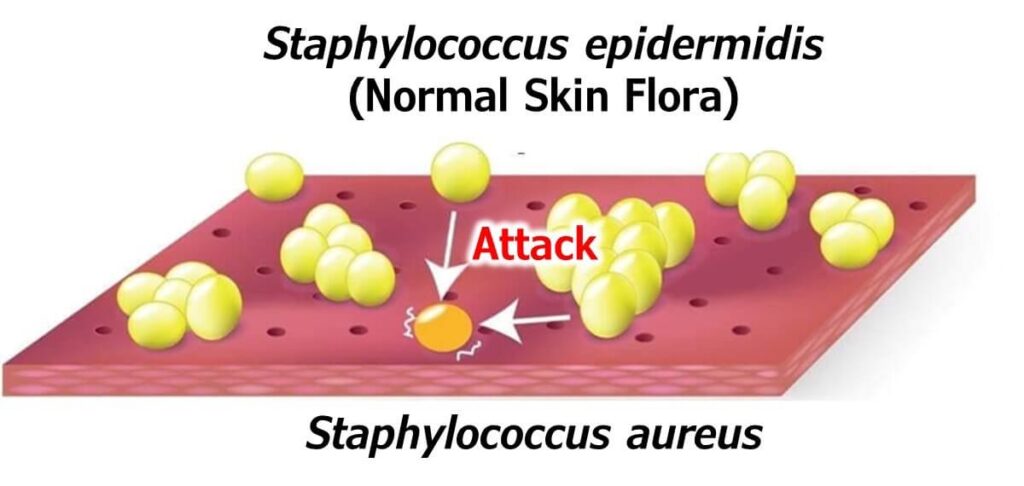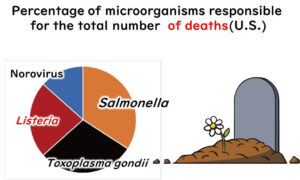Staphylococcus aureus, often referred to as S. aureus, is a notorious bacterium known for causing inflammation on the skin. This "bad guy" of the microbial world can lead to food poisoning and opportunistic infections. But is there a "good guy" that can combat S. aureus on our skin? For a long time, there was no clear scientific evidence. However, in 2017, Dr. Nakatsuji and colleagues from the University of California, San Diego, provided groundbreaking evidence that indeed there is a beneficial bacterium capable of eliminating S. aureus. They discovered that Staphylococcus epidermidis, a common skin bacterium, plays a crucial role in keeping S. aureus at bay.
Nakatsuji T. et al., Sci. Transl. Med. 9, eaah4680 22 (2017)
Antimicrobials from human skin commensal bacteria protect against Staphylococcus aureus and are deficient in atopic dermatitis
This paper is available on PubMed Central (PMC).
Understanding Staphylococcus: The Good, the Bad, and the Not-so-Ugly
When we talk about staphylococci, we're referring to a large family of bacteria that includes both harmful and harmless members. S. aureus is the villain here, responsible for food poisoning and opportunistic skin infections. Belonging to the Staphylococcus genus, S. aureus stands out due to its ability to produce coagulase, an enzyme that clots blood.
On the other hand, our skin hosts numerous other staphylococci, collectively known as coagulase-negative staphylococci (CoNS), which include species like S. epidermidis, S. hominis, S. warneri, S. pasteuri, S. saprophyticus, and S. xylosus. These bacteria are generally harmless and even beneficial, as they help maintain a healthy skin microbiome.
The coagulase test is a simple method to distinguish between S. aureus (coagulase-positive) and CoNS (coagulase-negative).
Friendly Skin Bacteria: Guardians Against Staphylococcus aureus
Dr. Nakatsuji and his team focused on the role of skin commensals—particularly coagulase-negative staphylococci (CoNS)—in protecting against S. aureus, especially in the context of atopic dermatitis (AD). Patients with AD often exhibit a disrupted skin microbiome, with an overgrowth of S. aureus that worsens their condition.
The researchers conducted a comprehensive screening of CoNS strains isolated from the skin of both healthy individuals and AD patients to assess their antimicrobial activity against S. aureus.

Their findings were significant:
- Coagulase-negative staphylococci with antimicrobial activity against S. aureus were prevalent in healthy individuals but rare in AD patients.
- S. epidermidis and S. hominis were found to produce previously unknown antimicrobial peptides (AMPs) that specifically target and kill S. aureus.
- Reintroducing these antimicrobial CoNS strains to the skin of AD patients reduced the proportion of S. aureus on their skin.
Thus, the study demonstrated that beneficial CoNS act as a defence mechanism against S. aureus, highlighting their role as "good bacteria" on our skin.
My Take on This Study

What struck me most in this study is the practical implication that protecting our skin’s natural microbiota can be just as important as sanitising it. From my perspective, the key takeaway is that S. epidermidis and other coagulase-negative staphylococci play an active role in defending against S. aureus, not merely by existing but by producing targeted antimicrobial peptides. This challenges the simplistic notion that "all bacteria must be removed"—an idea still pervasive in food safety routines.
The risk of superinfection—where overly aggressive disinfection eliminates both harmful and protective microbes—serves as a critical reminder for professionals in food safety and hygiene management. Especially in food processing environments, where hand hygiene is essential, we must strike a balance between cleanliness and microbiome preservation.
This confirms what I’ve long emphasised: in our pursuit of hygiene, we must not overlook the protective functions of indigenous microbes. Judicious hygiene practices, such as proper handwashing techniques that remove transient pathogens while sparing commensal bacteria, remain key.
For more on the relationship between handwashing and skin commensals, see my separate article. The Science of Handwashing: Removing Transient Bacteria vs. Managing Resident Flora

For a basic introduction to S. aureus, check out my article:
Exploring Staphylococcus aureus: From Skin Infections to Foodborne Illnesses – A Comprehensive Guide

